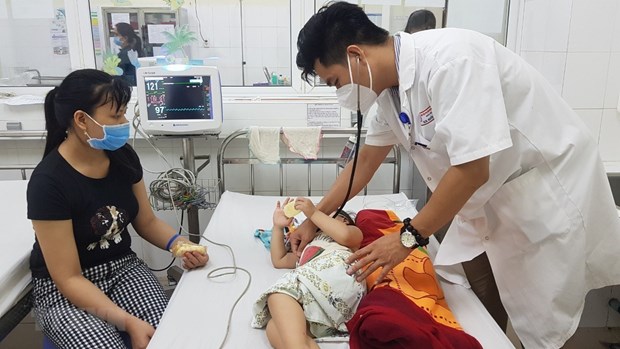
According to the Ministry of Health, the control system for communicable diseases has confirmed 5,545 cases of hand, foot, and mouth disease (HFMD) since the beginning of 2022, including one death in Binh Thuan province.
According to the Ministry of Health, the control system for communicable diseases has confirmed 5,545 cases of hand, foot, and mouth disease (HFMD) since the beginning of 2022, including one death in Binh Thuan province.
 |
| A child patient with hand, foot, and mouth disease (HFMD) is examined by a doctor in the central Da Nang City. |
Statistics show that compared to the same period in 2021, infections have decreased by 83.3 per cent, while fatalities dropped by nine cases.
However, the southern region is seeing a rise in the number of HFMD cases, particularly in HCM City and Dong Nai, Binh Duong, and Soc Trang provinces.
HFMD is a year-round disease in Viet Nam, transmitted through the gastrointestinal tract and found in almost every city and province. Infections usually peak around September to November every year.
It is forecasted in the upcoming months, the disease will continue on the rise due to its transmissible nature, limited hygiene skills in children, and the increase in transportation post-pandemic, with no vaccine available.
To proactively control HFMD and prevent prolonged widespread transmission, the Ministry of Health has required municipal and provincial People’s Committees to instruct all authorities to coordinate with the health sector, implementing comprehensive, stringent measures to avoid outbreaks, focusing on at-risk areas with high numbers of infections.
Local health departments are also ordered to monitor the situation closely, promptly detecting new infection clusters, strengthening emergency response teams to be ready for inspection, verification, evaluation, handling transmissions, and providing support in disease control and treatment when needed.
The health ministry ordered classification for examination and treatment, separate areas for patients with infectious diseases, and limiting visits from families while also minimizing deaths among severe cases.
It is important to prevent cross-infection inside medical facilities, especially with measles, pneumonia and other respiratory conditions.
Localities must prepare funding and medical supplies for treatment and emergency responses for different outbreak scenarios. Training and knowledge updates on the disease must be provided at all levels to enhance the capacity of medical staff, especially at the grassroots level.
Local departments of information and communications are instructed to cooperate with the healthcare sector to raise awareness of HFMD, informing households and communities through different means, including community gatherings and training, flyers, radio and television.
Schools need to communicate with their students on preventive measures against the disease, especially for nurseries and kindergartens. They must also practice hygiene, disinfect chairs, tables and toys, and ensure clean water and food safety in the shared kitchen.
If infection clusters are detected on campus, local health authorities must be notified immediately for prompt solutions.
(Source: VNS)




